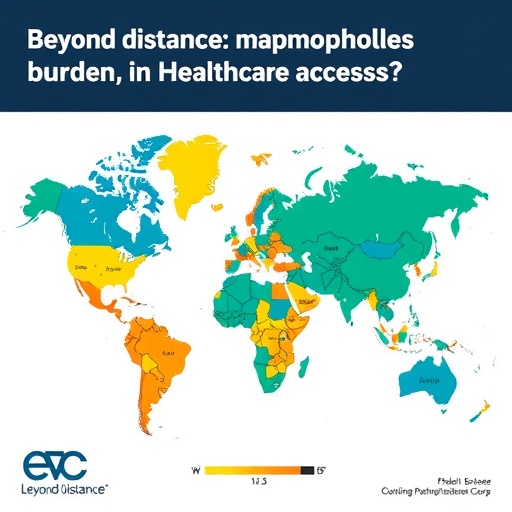In the quest to enhance global health outcomes, accessibility to primary healthcare facilities remains a pivotal challenge. Recent research led by Zhu, Chen, He, and collaborators pushes the boundaries of traditional healthcare accessibility assessments by proposing a novel framework that transcends mere physical distance. Their pioneering study, published in Global Health Research and Policy, redefines how we evaluate access to primary healthcare by integrating the economic burden experienced by patients alongside distance metrics, offering a far more nuanced and actionable picture of healthcare accessibility across diverse populations.
Traditional models of healthcare accessibility have predominantly focused on geographic factors—how far individuals must travel to reach a healthcare facility. While distance undoubtedly influences healthcare utilization, these models often overlook subtler, yet critical, barriers related to economic costs. Zhu and colleagues’ research addresses this gap by incorporating economic burden directly into accessibility analyses. This integration is revolutionary because it aligns healthcare service delivery more closely with the socio-economic realities confronting patients, especially in low- and middle-income countries where financial constraints severely impair access.
At the core of their study lies a sophisticated analytical framework that combines spatial data with socio-economic variables, capturing a spectrum of costs such as transportation expenses, opportunity costs including lost wages, and out-of-pocket payments for healthcare services. The methodology leverages large-scale datasets, integrating geographic information systems (GIS) with household income and expenditure data, thus enabling a layered understanding of accessibility that is both spatially precise and economically grounded.
One of the most striking findings of the study is how accounting for economic burden dramatically alters the landscape of healthcare accessibility. Areas previously deemed well-served when evaluated by distance alone often reveal stark economic barriers, exposing vulnerable populations who, despite geographic proximity, face insurmountable financial obstacles to healthcare. This insight challenges policymakers to rethink resource allocation and underscores the insufficiency of infrastructure-focused interventions without consideration of economic dimensions.
The implementation of this integrated model on a large scale presents technical challenges, notably in data integration and quality. Zhu et al. tackled this by employing advanced data harmonization techniques, ensuring consistency and comparability across heterogeneous data sources. Their use of machine learning algorithms for imputing missing economic data exemplifies the innovative approach needed to overcome traditional data limitations in health systems research.
Crucially, this research provides a scalable blueprint for health systems worldwide to incorporate economic considerations into accessibility assessments. By demonstrating its feasibility in different socio-economic contexts and geographic settings, the study underscores the model’s adaptability—making it a valuable tool for countries grappling with disparities in healthcare utilization and outcomes.
Beyond the methodological advancements, the implications for health policy and planning are profound. By revealing hidden barriers masked by conventional distance-based metrics, this approach enables targeted interventions that can be tailored to reduce economic burdens—be it through subsidized transportation, reduced fees, or conditional cash transfers aimed at enabling health service utilization.
Moreover, employing this comprehensive accessibility model can sharpen monitoring and evaluation frameworks for universal health coverage (UHC). It offers a more accurate indicator of whether populations truly have access to essential healthcare services, helping bridge the gap between policy goals and patient realities.
Zhu and colleagues also highlight the social justice dimension intrinsic to this integrated approach. By foregrounding economic burden, the study brings equity concerns to the forefront—highlighting how poverty and financial hardship compound access issues and exacerbate health disparities, thereby advocating for more equitable health system designs.
Technological innovations underpinning this research deserve emphasis. The use of GIS mapping combined with economic analytics represents a cutting-edge synthesis of spatial science and health economics, pushing the envelope in health services research. The team’s use of open-source software tools ensures replicability and accessibility, encouraging widespread adoption and continuous refinement by the global health research community.
The broader research community stands to benefit from this work by using it as a basis for exploring other dimensions of healthcare accessibility, such as cultural barriers and quality of care. The integrated economic-spatial model opens new avenues for multidisciplinary research, uniting geographers, economists, health workers, and policymakers in crafting holistic solutions.
Ethical considerations embedded in the research design reflect the sensitive nature of collecting economic data linked to individual healthcare access. The authors detail rigorous privacy protection methods and emphasize community engagement to ensure that data use aligns with participant rights and fosters trust—an essential foundation for sustainable health data initiatives.
This groundbreaking research arrives at a critical time as global health systems confront intertwined challenges of pandemics, chronic diseases, and growing inequalities. It provides a timely recalibration of accessibility frameworks, supporting more resilient and responsive primary healthcare systems capable of addressing not just where services are located but at what cost they can be used.
Looking ahead, further research could expand this integrative model by incorporating dynamic economic fluctuations, such as those induced by economic crises or health shocks at the household level. Real-time data integration and mobile technology platforms could enhance the model’s applicability in rapidly changing environments and crisis contexts.
In conclusion, Zhu, Chen, He, and their team have delivered a transformative report that re-envisions healthcare accessibility with a comprehensive lens. By incorporating the economic burden into spatial models of access, they grant policymakers a powerful new tool for tackling inequities that have long hindered progress toward universal health coverage. This approach heralds a new era in public health planning—one that acknowledges access to care as a function of both physical distance and financial feasibility, and ultimately, as a fundamental human right.
Article References:
Zhu, B., Chen, L., He, Y. et al. Beyond distance: integrating economic burden into large-scale primary healthcare accessibility analysis. Glob Health Res Policy 10, 53 (2025). https://doi.org/10.1186/s41256-025-00451-9
Image Credits: AI Generated




